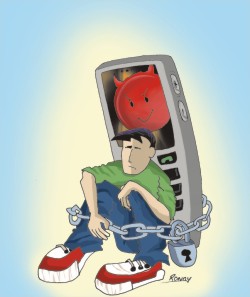
By Adnan Quadri
Buzz…buzz…buzzzzzz… almost everyday I wake up hearing these buzzing sounds. The definite source of this commotion is not flies no, it is my portable, fashionable, tiny cell phone. Cell phone!
The first two sentences that can follow these two words are “The quickest means of communication” and “Erosion of privacy”. I am the victim of the latter, honestly speaking. Cell phones have had a great influence on people all over the world and now they are all around us whether safely tucked in a man's pocket or stashed under lipsticks and make-up in a woman's vanity bag. It is the plague of our times, the virus none of us can escape, even if we want to.
Just walk out from your house without your cell phone. You will feel the difference. Your empty pocket will seem to vibrate with the want of something that is missing. It is considered sheer lunacy to start a day without a cell phone.
I mean, maybe it is not really that serious, but it certainly feels that way. It is the newly discovered cell that lives outside our body “THE PHONE CELL” .
 In fewer than twenty years, mobile phones have gone from being rare and expensive pieces of equipment used by businesses to a pervasive low-cost personal item. Mobile phones now outnumber land line telephones, with most adults and many children now owning mobile phones.
In fewer than twenty years, mobile phones have gone from being rare and expensive pieces of equipment used by businesses to a pervasive low-cost personal item. Mobile phones now outnumber land line telephones, with most adults and many children now owning mobile phones.
It is not uncommon for young adults to simply own a mobile phone instead of a land line for their residence. With such a high level of mobile telephone penetration, a mobile culture has evolved where the phone becomes a key social tool and people rely on their mobile phone address books to keep in touch with their friends. Another option for interaction is of course the much hyped about SMS. Many phones even offer Instant Messenger Services to increase the simplicity and ease of communication.
The mobile phone itself has also become a totemic and fashion object, with users decorating, customising and accessorising their mobile phones to reflect their personalities. Mobile phone etiquette has become an important issue with mobiles ringing at funerals, weddings, movies and plays.
Users often speak at increased volume, which has led to places like bookshops, libraries, movie theatres, doctor's offices, and houses of worship posting signs prohibiting the use of mobile phones. Most schools in the US prohibit the use of cell phones because they disrupt class and because they facilitate the option of photographing someone (without consent).
Camera phones, video phones and phones with recording facilities are able to capture video, still images and entire conversations. TV channels make good use of these privileges by sometimes using mobile phones to cover breaking news. Stories like the London Bombings, the Indian Ocean Tsunami and Hurricane Katrina have been reported by camera phone users on photo sharing sites like Flicker.
Mobile phones communicate through electromagnetic microwaves with a cell site base station, the antennas of which are usually mounted on a tower, pole or building. The phones have low power transceivers that transmit voice and data to the nearest cell sites, usually 5 to 8 miles away. When the cellular phone or data device is turned on, it registers with the mobile telephone exchange or switch with its unique identifiers and is then alerted by the mobile switch when there is an incoming call.
The handset is constantly alert to pick up the strongest signal being received from the surrounding base station. As the user moves around the network, the mobile device will “hand-off” to various cell sites during calls, or while waiting between calls it will reselect cell sites. Cell sites have relatively low-power (often only one or two watts) radio transmitters, which broadcast their presence and relay communication between the mobile handsets and the switch.
The switch in turn connects the call to another subscriber of the same service provider to the Public Switch Telephone Network (PSTN).
I apologise for the elaboration, but trust me this is how it really works. Now do not think that standing beside a tower or antennae will speed up your service. A call has to make its way through various stations and then it ultimately reaches its final destination.
Not just the cell phone service providers but also the cell phone manufacturers are coming up with innovative ideas. Mobile phones now have features beyond sending text messages and making voice calls- including Internet browsing, music (MP3) playback, personal organisers, e-mail, built-in cameras and camcorders, ring tones, games, radio, Push-to-Talk (PTT), infrared and Bluetooth connectivity, call registers, ability to watch streaming videos or download videos for later viewing.
Cell phones are not just phones now but can be referred to as cameras or MP3 players. To me the change is more evolutionary then revolutionary. With increasing demand for simplicity and multitasking, the change was very much needed. In fact we are now no more the cell phone users. We are now used by the cell phone. We can but wait to see what happens in the near future.
